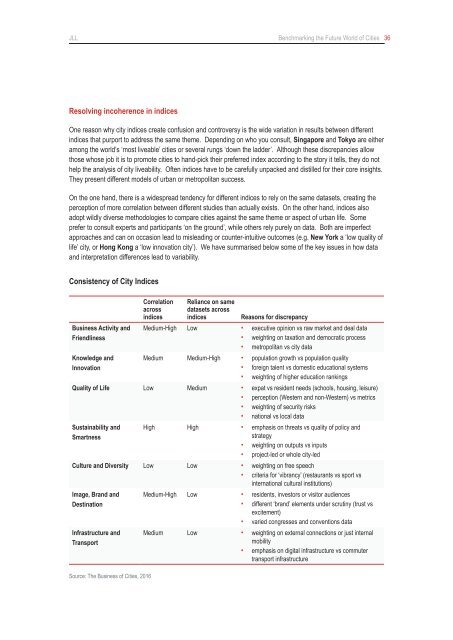Benchmarking the Future World of Cities
jll-business-of-cities-report-april-2016
jll-business-of-cities-report-april-2016
You also want an ePaper? Increase the reach of your titles
YUMPU automatically turns print PDFs into web optimized ePapers that Google loves.
JLL <strong>Benchmarking</strong> <strong>the</strong> <strong>Future</strong> <strong>World</strong> <strong>of</strong> <strong>Cities</strong> 36<br />
Resolving incoherence in indices<br />
One reason why city indices create confusion and controversy is <strong>the</strong> wide variation in results between different<br />
indices that purport to address <strong>the</strong> same <strong>the</strong>me. Depending on who you consult, Singapore and Tokyo are ei<strong>the</strong>r<br />
among <strong>the</strong> world’s ‘most liveable’ cities or several rungs ‘down <strong>the</strong> ladder’. Although <strong>the</strong>se discrepancies allow<br />
those whose job it is to promote cities to hand-pick <strong>the</strong>ir preferred index according to <strong>the</strong> story it tells, <strong>the</strong>y do not<br />
help <strong>the</strong> analysis <strong>of</strong> city liveability. Often indices have to be carefully unpacked and distilled for <strong>the</strong>ir core insights.<br />
They present different models <strong>of</strong> urban or metropolitan success.<br />
On <strong>the</strong> one hand, <strong>the</strong>re is a widespread tendency for different indices to rely on <strong>the</strong> same datasets, creating <strong>the</strong><br />
perception <strong>of</strong> more correlation between different studies than actually exists. On <strong>the</strong> o<strong>the</strong>r hand, indices also<br />
adopt wildly diverse methodologies to compare cities against <strong>the</strong> same <strong>the</strong>me or aspect <strong>of</strong> urban life. Some<br />
prefer to consult experts and participants ‘on <strong>the</strong> ground’, while o<strong>the</strong>rs rely purely on data. Both are imperfect<br />
approaches and can on occasion lead to misleading or counter-intuitive outcomes (e.g. New York a ‘low quality <strong>of</strong><br />
life’ city, or Hong Kong a ‘low innovation city’). We have summarised below some <strong>of</strong> <strong>the</strong> key issues in how data<br />
and interpretation differences lead to variability.<br />
Consistency <strong>of</strong> City Indices<br />
Business Activity and<br />
Friendliness<br />
Knowledge and<br />
Innovation<br />
Correlation<br />
across<br />
indices<br />
Reliance on same<br />
datasets across<br />
indices<br />
Reasons for discrepancy<br />
Medium-High Low • executive opinion vs raw market and deal data<br />
• weighting on taxation and democratic process<br />
• metropolitan vs city data<br />
Medium Medium-High • population growth vs population quality<br />
• foreign talent vs domestic educational systems<br />
• weighting <strong>of</strong> higher education rankings<br />
Quality <strong>of</strong> Life Low Medium • expat vs resident needs (schools, housing, leisure)<br />
• perception (Western and non-Western) vs metrics<br />
• weighting <strong>of</strong> security risks<br />
• national vs local data<br />
Sustainability and<br />
Smartness<br />
High High • emphasis on threats vs quality <strong>of</strong> policy and<br />
strategy<br />
• weighting on outputs vs inputs<br />
• project-led or whole city-led<br />
Culture and Diversity Low Low • weighting on free speech<br />
• criteria for ‘vibrancy’ (restaurants vs sport vs<br />
international cultural institutions)<br />
Image, Brand and<br />
Destination<br />
Infrastructure and<br />
Transport<br />
Source: The Business <strong>of</strong> <strong>Cities</strong>, 2016<br />
Medium-High Low • residents, investors or visitor audiences<br />
• different ‘brand’ elements under scrutiny (trust vs<br />
excitement)<br />
• varied congresses and conventions data<br />
Medium Low • weighting on external connections or just internal<br />
mobility<br />
• emphasis on digital infrastructure vs commuter<br />
transport infrastructure


